Geheimnisse der Unwucht 3
01.11.2021
Dieses Video ist eine Zusammenfassung der Geheimnisse der Unwucht, Teil 1 und 2. Es sollte ein kleines Kochbuch mit Schritt-für-Schritt-Anleitungen und wichtigen Regeln zum Auswuchten sein. Es wäre besser, wenn Sie sich die vorherigen Teile ansehen würden. Aber wenn Sie sich nur diesen Teil ansehen, erhalten Sie eine vollständige Beschreibung, wie Sie die Position der schweren Stelle finden und verwenden.
Wenn Sie den Rotor auswuchten, machen Sie den ersten Lauf und montieren dann die Probemasse. Normalerweise an einer zufälligen Position.
Es kann jedoch gefährlich sein, wenn Sie sie in der Nähe der Position der schweren Stelle montieren.
In einem solchen Fall werden die Vibrationen zunehmen und es kann etwas beschädigt werden.
Der bessere Ansatz ist, die Probemasse auf der dem schweren Punkt gegenüberliegenden Seite zu montieren. Dadurch werden die Vibrationen verringert. Und das können Sie tun.
Nach dem ersten Lauf kennen Sie die Position der schweren Stelle. Sehen Sie sich dieses Video an.
Die meisten Leute verwenden den Beschleunigungssensor zur Messung. Wir werden es auch in diesem Video verwenden.
Es ist besser, zwei Dinge beizubehalten, die den Vorgang vereinfachen. Das erste ist, das reflektierende Band in der Null-Grad-Position zu montieren.
So.
Das zweite ist, die gleiche Richtung von Beschleunigungsmesser und Tacho beizubehalten.
Dies ist ein einfaches Beispiel für eine Schleifmaschine.
Die grundlegende Ausgleichsmessung ist Amplitude und Phase der Geschwindigkeitsfrequenz.
Das Adash-Instrument verwendet dafür den Namen Amp+Phase.
Die Amplitude wird normalerweise in Geschwindigkeit angegeben. Das bedeutet mm/s.
Sie kann aber auch in g angegeben werden.
Die letzte verfügbare Einheit sind Verschiebungsmikrometer. Das bedeutet jedoch zwei Integrationen aus der Beschleunigung. Die Werte können etwas ungenau sein. Aber wenn Sie einen Wirbelstromsensor verwenden, ist es perfekt.
In diesem Beispiel erklären wir, wie man Zahlen aus der Amp+Phase-Messung verwendet. Wir verwenden nur den Phasenwert.
Es ist ganz einfach. Die Verschiebungsphase entspricht der Position des Schwerpunkts. Beide sind in Grad angegeben. Von der Geschwindigkeitsphase müssen wir 90 Grad abziehen, um die Position des Schwerpunkts zu erhalten. Für die Beschleunigung müssen wir 180 Grad abziehen.
Wenn wir in diesem Beispiel Zahlen abziehen, erhalten wir aus allen drei Messungen Null.
Die Null bedeutet, dass sich der Schwerpunkt an derselben Position wie das Reflektorband befindet, da die Bandposition Null ist.
Hier ist der Wert gleich plus 70 Grad.
Wenn der Phasenwert positiv ist, messen wir in derselben Richtung wie die Rotation. Wenn der Wert negativ ist, messen wir gegen die Rotation. Wir können hier fünf Klingen sehen. Die 360 Grad geteilt durch 5 ergeben ungefähr 70 Grad. Das bedeutet, dass die schwere Stelle ein Blatt von der Nullposition entfernt ist.
Der Wert ist minus, wir müssen gegen die Rotation vorgehen. Der Unterschied zwischen den Blättern beträgt 70 Grad. Das bedeutet, dass die schwere Stelle zwei Blätter von der Nullposition entfernt ist.
Jetzt kehren wir zum Startbildschirm zurück. Wir haben den Rotor mit der schweren Stelle und kennen die Position.
Jetzt ist es einfach, die Probemasse auf der gegenüberliegenden Seite zu montieren und die Vibration zu verringern. Wenn die Probemasse zu schwer ist, kann die Vibration natürlich zunehmen.
Und die wichtige Information zum Schluss. Alle genannten Regeln gelten nur für starre Rotoren, nicht für flexible Rotoren.
Das bedeutet, dass die Drehzahlfrequenz niedriger als die erste Resonanz sein muss. Sie können mit höherer Drehzahl arbeiten, müssen aber nach jeder Resonanz 180 Grad hinzufügen.





